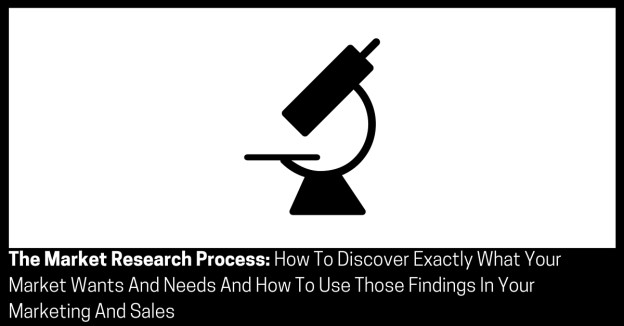Approximate read time: 5 minutes
Market research is success insurance!
What is market research?
Market research “is any organized effort to gather information about customers.”
Amazon.com uses a process called “working backward” for new product, service or solution creation.
Amazon’s CTO, Werner Vogel, said: “Start with your customer and work your way backward until you get to the minimum set of technology requirements to satisfy what you try to achieve.”
They write the press release, the Frequently Asked Questions and user manual all before the product, service or solution is created.
One of the best quotes I have read on this is by serial entrepreneur, Steve Blank:
“Marketing’s primary role at a startup is to drive sales. Marketing’s job is to make the VP of Sales the richest person in the company. How does marketing do that? Well, marketing’s job number one was to understand customers’ needs, desires, etc. and make sure engineering understood those as well”.
How do you do this?
Here are the elements:
- STEP 1: Contact Database;
- STEP 2: Market Research;
- STEP 3: Confirm Findings; and
- STEP 4: Add Findings.
Let’s begin with…

1) Contact Database
…This step is about your contact database.
Here you have the first decision tree.
Do you have a contact list of prospects and customers?
If you don’t have one, then you need to build a seed list of prospects and customers.
If you do have a contact list of prospects and customers, then you need to ask if you can talk to them about their pains and gains that your product, service or solution can solve.
Of course, the exact details of how to do this are beyond the scope of this guide.
So in summary, this step is about contact database.
This leads us to market research…

2) Market Research
…This step is about market research.
Once you have a contact database, you come across the second decision tree.
If your prospects and customers do not want to talk to you about their pains and gains that your product, service or solution can solve, then no further action is needed with that segment.
If your prospects and customers do want to talk to you about this, then you need to ask them specific market research questions.
The questions revolve around a few main areas, both external and internal:
- Demographics;
- Pains;
- Gain; and
- Solutions.
The process of asking or interviewing them, in the first instance, is qualitative research, which is investigative research to understand their answers deeply by asking further questions if necessary.
This means it is best to talk to people face-to-face or over the phone and not use email or surveys.
There is a place for surveys, which comes later.
Offering a survey at this stage means that you run the risk of asking leading questions.
In law, there is an evidential question called a leading question.
A leading question is a question you ask to hear the information you want to hear.
Put another way, it is a question that prompts or encourages the answer sought.
In other words, it’s information that will confirm any bias you already have.
A survey only has limited information that has no scope for organic follow up questions like an interview does.
It misses a lot of vital information you don’t know or don’t know that you don’t know.
You need to be asking the “5 Why’s” behind each answer to get to core of the answer:
Why, why, why, why, why!
Your bias and assumptions may not actually align with what your prospects and customers truly want.
These biases are not helpful in the context of marketing and sales, as it will mean you are not addressing exactly what your prospects and customers need.
After you have done this with one prospect or customer, you need to repeat it at least 20 times with 20 plus other prospects or customers, or until you see answers with common denominators starting to emerge.
Don’t count the outlines.
The reason for this is statistical significance.
Of course, the exact details of how to do this are beyond the scope of this guide.
This step is about market research.
This leads us to confirm your findings…

3) Confirm Findings
…This step is about confirming your findings.
Once you have completed your market research, then you need to confirm and validate this research via a survey.
Here is where surveys are relevant.
This is quantitative research.
You need to add the common denominators to the survey and ask if they are true.
You need to repeat this at least 20 times with 20 plus prospects or customers, or until you see answers with common denominators starting to emerge.
Don’t count the outlines.
The reason for this is statistical significance.
Of course, the exact details of how to do this are beyond the scope of this guide.
This step is about confirming your finding.
This leads us to add your findings to your marketing and sales…

4) Add Findings
…This step is about adding your findings to your marketing and sales.
Once you have your qualitative and quantitative research findings, you will then need to add your findings to your marketing and sales.
This could be to inform your content and conversion.
Of course, the exact details of how to do this are beyond the scope of this guide.

Take Action
You made it…
You now have a solid plan for discovering exactly what your market wants and needs and how to use those findings to your marketing and sales.
That’s the full Market Research Process, and it will be more than enough for you to get started on your own.
You can get the printed illustrated Process Map of this and 20 others for free, here
And if you’re serious about marketing and selling more, the logical next step is to contact me to help you do it yourself, have me do it with you, or have it all done for you.
This maybe the momentum you need to get great marketing and sales results.
Now let’s learn about The Brand Creation Process.
Or do you simply want more like this?
Join below to be notified immediately about new content and more. No annoying daily emails and no spam – just good content when it’s posted.

